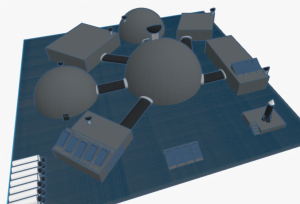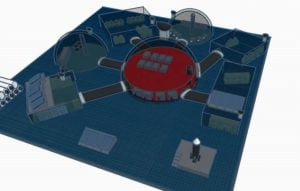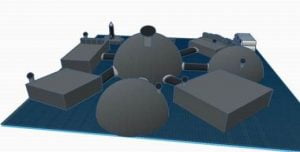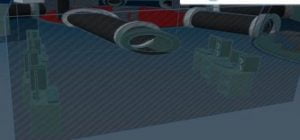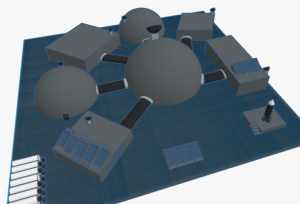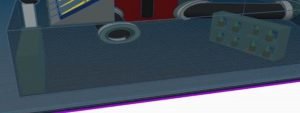Moon Camp Explorers Gallery 2020-2021
In Moon Camp Explorers each team’s mission is to 3D design a complete Moon Camp using Tinkercad. They also have to explain how they will use local resources, protect astronauts from the dangerous of space and describe the living and working facilities.
Team: Insight 2
International School of Toulouse Colomiers France 13
External link for 3d
|
Project description
Our Moon Camp’s name is Insight 2. We were inspired by the NASA Insight mission, launched in 2018, which is an example of persistence and tenacity despite the obstacles faced after the Mole struggled to make it underground due to lack of friction in the soil. The heat probe was built and developed by the German Aerospace Centre; after getting the top of the Mole about 2 or 3 centimetres under the surface, the team tried one last time to use a scoop on InSight’s robotic arm to scrape soil onto the probe and tamp it down to provide added friction. After the probe conducted 500 additional hammer strokes on Saturday, January 9, with no progress, the team called an end to their efforts. Insight 2 is a lunar camp with plans to live on the Moon and acquire water, food and oxygen sustainably. Our base consists of a landing platform, plutonium generator and a rover used for exploring lunar terrain. It will also consist of eight sections, including a water and air recycling facility which work in conjunction; food storage; communications; one sleeping dormitory for 2 astronauts; a hydroponics facility; a garage and finally the main section. The main section includes an IT room, dining room and kitchen. We made our base close to the lunar poles, on the south side, so that we could observe the Moon easily and have some sunlight coming in. Having sunlight and visibility will improve the physical and mental health of our astronauts. |
|||
|
Where do you want to build your Moon Camp?
Close to the Lunar Poles Why did you choose this location?
We will place our base on the south Lunar Poles. This proximity will allow us to access the record amounts of ice in the crater and melt them for treatment and use. Thanks to the perpendicular spin axis of the moon, there is constant light shining on the horizon at the poles. It will shine on the poles all year round, regardless of the orbit. This light will be used for electricity generated by solar panels. Vitamin D provided by the sun and consistent light sources will also benefit the mental status of our astronauts and improve quality of life. How do you plan to build your Moon Camp? Which materials would you use?
The architecture of our Moon Camp is based on layers of materials which provide insulation, radioactive protection, physical protection, and magnetism. We will insulate the base using lunar soil, which is an excellent insulator for keeping heat in. For protection we are going to use titanium (which will be the first exterior layer) which is extremely lightweight and strong. For radioactive protection we will use a Wolfmet Tungsten Alloy, which is a good blocker of radiation (gamma and x-ray) thus serving as protection to our astronauts. Iron will be used for magnetic boots (instead of artificial gravity). Explain how your Moon Camp will provide the astronauts with:
|
|||
|
Water
|
Food
|
Electricity
|
Air
|
|
We will produce water by recycling urine using the still apparatus (with the condenser being shorter and colder to increase speed). The urine will be filtered and treated after distillation in order to ensure hygenity. We will also be melting ice from the lunar south poles (where our base is) but as this will be limited, we shall sample a piece of ice on a monthly basis for experimental documentation. |
For food we shall use a hydroponics chamber, which passes a nutrient solution (also mixed with faeces from the toilet) and pumps the solution around this piping system. The plant’s roots will be in the solution and will be held in place by rubber balls. We will grow broccoli, brussels sprouts, chard, cabbage, spinach, kale, carrots, and sweet potatoes on a tri-yearly rotation in order to ensure variety in the astronaut’s diet and a full range of nutrients. For extra nutrition for the plants we will use artificial light for photosynthesis as the Moon’s light can get extremely powerful. |
Power will be produced by solar panels and reactors through nuclear fission. The reactors will be underground in a protective chamber to avoid any igniting substance setting it off. The solar panels will have a voltage check every ten seconds for damage control and maximum power output. |
Breathable air will be produced primarily by the electrolysis of water, but as this produces pure oxygen, we will use the nitrogen from the farm and soil, and the hydrogen from the electrolysis. We will separate the hydrogen into two equal parts, one for the compound and one for fuelling purposes. The air will be ventilated through the Moon Camp and the carbon dioxide breathed out by astronauts will be recycled by plants. The air generator will get water every two days. |
|
Describe a day on the Moon for one of your Moon Camp astronauts
The astronauts will get out of bed at 6am by detaching themselves from their beds, then go to the bathroom to get washed and brush their teeth. All astronauts will go and check the filtration systems for ample supplies of water and oxygen with no damage or leaks. Then they will go and have breakfast in the main dome, eating together on one table to limit space and taking daily turns to make the meal. Afterwards, they need to go and check the hydroponics chamber in case of any leaks or blockages, check the pumping system, and resupply the reservoir every two days. Then they will go to the control room to activate voltage checks for the solar panels. If there is any low voltage production, then they need to put on their space suits and locate the damaged solar panel to fix it. After lunch, the astronauts need to put back on the space suits and leave through the airlock. If conditions allow, they will clean any large pieces of debris off the solar panels. Then if they need to, they go to the water closets which are spread across the whole base. They shall activate the rover to check the radiation levels and to do other exploratory activities. Finally, they will go to the hydroponics to harvest some food for dinner. At the end of the day, they go to their chambers and take care of hygiene and strap themselves in for the next day. |
|||


